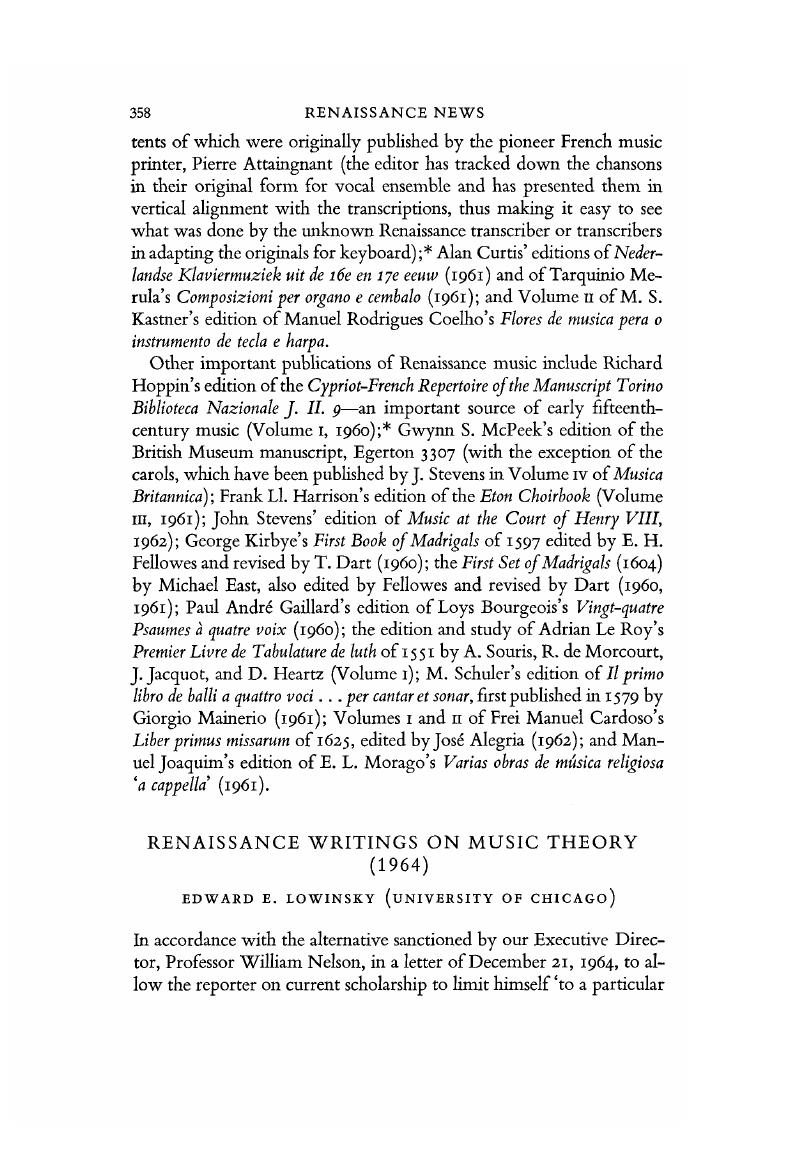Published online by Cambridge University Press: 20 November 2018

1 See Weinberg, Bernard, A History of Literary Criticism in the Renaissance, 2 vols. (Chicago, 1961)Google Scholar.
2 Documenta Musicologica (Kassel and Basel, 1951 ff.), which has published so far twenty-five treatises, eight of which belong to the Renaissance. Welcome as this enterprise is, it is entirely inadequate to our needs because it also publishes books from periods other than the Renaissance, it leaves out handwritten theoretical sources, it cannot offer a substitute for critical editions, and it moves with painful slowness.
3 On the difference between music theory in the Middle Ages and in the Renaissance, see the author's ‘Music of the Renaissance as Viewed by Renaissance Musicians’ in The Renaissance Image of Man and the World (Columbus, Ohio; in process of publication).
4 On the distinction between counterpoint and composition see this writer's ‘Musical Genius—Evolution and Origins of a Concept,’ Musical Quarterly, L (1964), 321-340 and 476-495. esp. pp. 481 ff.
5 The true meaning of the rhyme is also obscured in Albert Seay's translation in his edition of Tinctoris’ treatise on counterpoint, with which we shall deal presently, when he writes (p. 5):
Great is the distance between musicians and singers; The former know, the latter mouth what makes music; And he who mouths what he does not know is defined as an animal.
6 On the cunning use of Guido's old definition in an entirely un-Guidonian spirit—a use so ingeniously concealed that it escaped even the most recent students of Tinctoris— see the essay cited in note 3.
7 Compare with this Seay's translation (p. 127): ‘For a song is ornamented when an ascent or descent is made from one concord to another by compatible means and by syncopations which cannot occasionally be made without discords.'
8 Compare again Seay's translation (p. 127 f.): ‘These particular small discords, therefore, do not represent themselves so vehemently to the hearing, since they are placed above the last parts of notes, as if they were used above the first [parts]. Musical sounds, to be sure, are made from a violent motion; hence, if violent motion is their nature, so it is abated near the end. The consequence is that the second parts of notes are not of as violent a sound as the first.’ It is hardly necessary to comment on the obtuse character— to put it mildly—of these translations.
9 For further documentation see the writer's ‘Early Scores in Manuscript,'Journal of the American Musicological Society, XIII (1960), 126-173, 161-167.
10 ‘Quos quidem cantus pro conformatione [Bologna has ‘confirmatione’] hujus nostrae regulae meis quidem praetermissis in exempla non ab re produxi. Enim vero et eos summis laudibus extollendos et penitus imitandos censeo, ne contra officium boni viri me solum probare, alios autem, ubi recte fecerint, contemnere videar’ (Cous. IV, 152b).
11 ‘… ejus plurimum sonora, dulcis et perfecta exindeque notis extremis praecipue perfectionalibus frequentissime imo fere semper accommodanda. Quamvis etiam non parum suavitatis afferat, si mediis congrue fuerit adaptata’ (Cous. IV, 105a). Seay misread non parum suavitatis as if it were non parent suavitatem.
12 ‘Neque tunc b mollis signum apponi est necessarium, immo si appositum videatur, asininum esse dicitur’ (Cous. iv, 22a).
13 The first volume of a bibliography of medieval treatises up to 1400 has been published recently by the International Musicological Society and the International Association of Music Libraries under the title The Theory of Music from the Carolingian Era up to 1400, edited by J. Smits van Waesberghe with the collaboration of Peter Fischer and Christian Maas. As far as I can discover, no plan exists to carry this project on through the Renaissance.
14 Åke Davidsson recently published a Bibliographie der Musiktheoretischen Drucke des 16. Jahrhunderts (Baden-Baden, 1962) as volume IX of Bibliotheca Bibliographica Aureliana, in which over 600 prints are listed together with a bibliography of the library catalogues from which this list was assembled. Helpful as this inventory is, particularly for its references to the various libraries in which the prints can be found, it is incomplete in a number of respects: it leaves out all incunabula; it limits itself to works found in library and sales catalogues (a great many music libraries have either no printed catalogues or no complete listings of theoretical books), but it is by no means complete in this field (a superficial check shows that the following catalogues have not been consulted: Damerini, Adelmo, ed., Esposizione Nazionale dei Conservatori Musicali e delle Biblioteche, [Florence, 1950]Google Scholar; Coussemaker, Edmond de, Notice sur les Collections Musicales de la Bibliothèque de Cambrai [n.p., n.d.]; Maggs Bros. [Catalogue] No. 849: Florence and Tuscany, Music [London, 1958]Google Scholar; Catalogus van de Bibliotheek der Vereeniging voor Nederlandsche Muziekgeschiedenis [Amsterdam, 1919]; Muziekhistorisch Museum van Dr.Scheurleer, D. F., Catalogus van de Muziekwerken en de Boeken over Muziek ['s-Gravenhage, 1923]Google Scholar); it confines itself to the mere listing of author, title, place and date of publication. In a future, more comprehensive work one ‘would hope for descriptive and analytical commentaries. Moreover, just in the last years a great many new catalogues, particularly of Italian libraries, have appeared which ought to be taken into account. A final severe limitation is the fact that Davidsson was only in exceptional cases in a position to see the works which he listed.
15 Here it can be reported that a Handwörterbuch der musikalischen Terminologie under a plan initiated by the late Wilibald Gurlitt is in preparation in Germany under the direction of Eggebrecht, H. H., who, in his Studien zur musikalischen Terminologie (Abhandlungen der Geistes- und Sozialwissenschaftlichen Klasse der Akademie der Wissenschaften und der Literatur, Wiesbaden, 1955)Google Scholar gives a preview of problems and methods.